AMD Ryzen 5 3500X Review
If you oasis't heard about the Ryzen 5 3500X until at present it's probable considering this CPU is more often than not existence sold and marketed to OEMs and arrangement integrators, depending on where you're located. Initially it was reported every bit an OEM-only part for the Chinese market, but and so appeared in other regions such equally Republic of india. Turns out you can pretty much buy the 3500X anywhere, though the weather condition will vary from 1 region to another.
In China information technology appears to be selling as a regular retail product that comes in a box with cooler and all. In Commonwealth of australia, you can only purchase the 3500X in a pre-built PC. Which nevertheless begs the question, how well does it perfom and what's changed from the R5 3600?
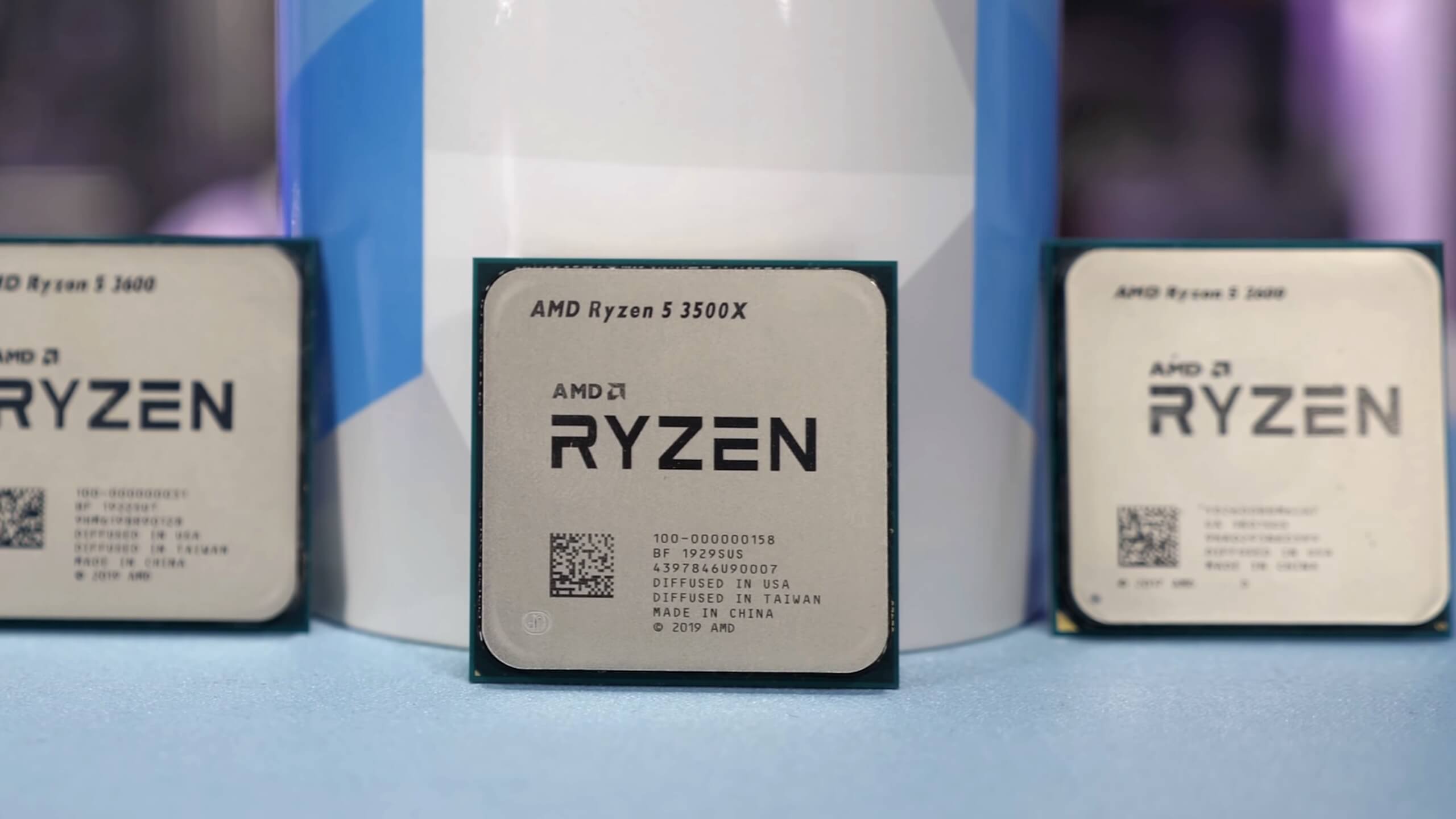
We've heard through channels that in order to learn the 3500X from AMD to use equally a organization integrator, there are quite a few hoops to jump through. You have to allow them know your plans, what kind of arrangement you intend to build, and the volume you lot expect to motion. We've likewise heard they're only beingness sold in big volumes, and so 1,000+ chips.
Anyway, the Ryzen 5 3500X has been available for purchase at AliExpress for over a month and the second they were listed we snapped one upwards for what amounted to $157 delivered. It'due south been sitting on our desk for a few weeks now, so we idea we better test this affair out or information technology was merely never going to happen.
Allow's chop-chop become over the specs of the 3500X...
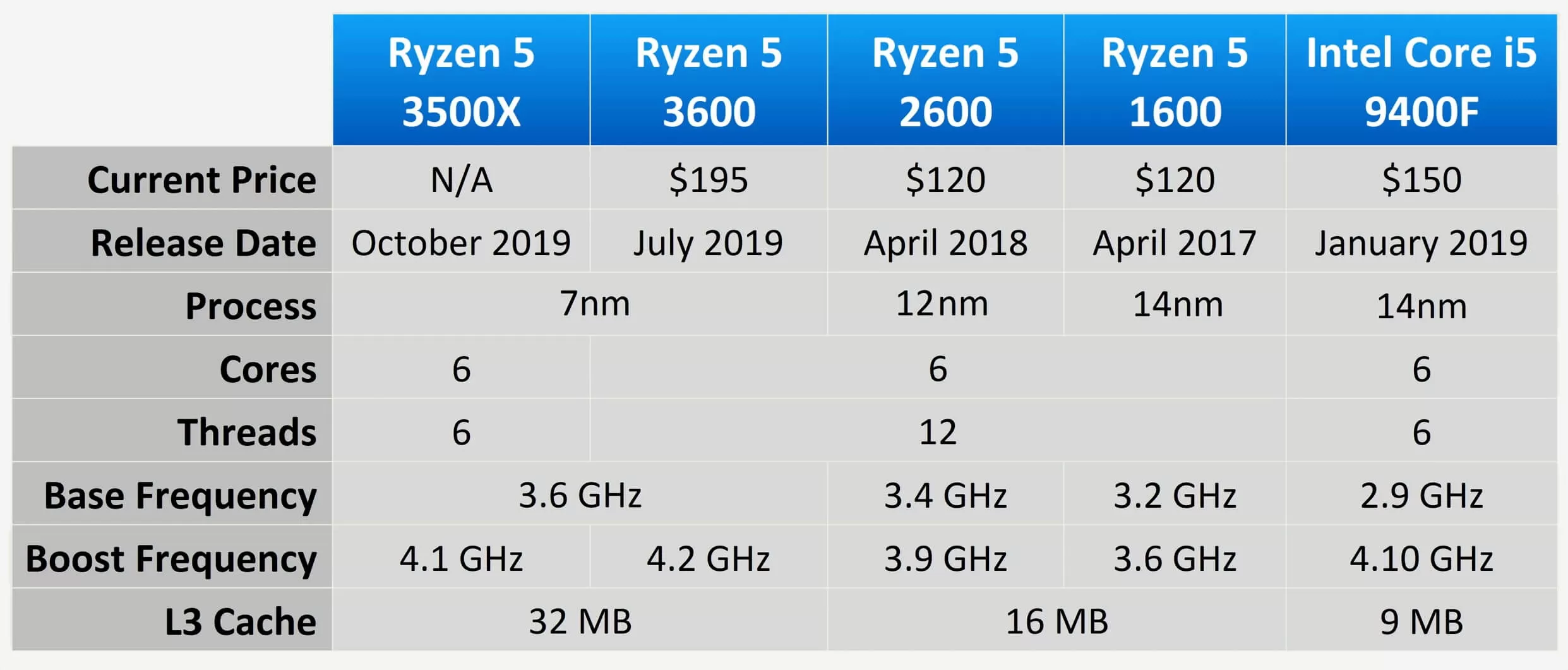
Like the 3600, it packs one-half a dozen Zen 2 cores that come clocked at 3.vi GHz for the base of operations. Depending on the workload they tin can clock as high as four.1 GHz out of the box, just 100 MHz lower than that of the 3600. The key difference is the lack of SMT (simultaneous multithreading) back up for the 3500X, where the R5 3600 packs six-cores / 12-threads, the 3500X features just 6 threads, much like the Cadre i5-9400F.
Is dropping SMT support for a ~thirty% discount from the R5 3600 worth it? (in Australia, again, this volition vary on your location). For U.s.a.-based shoppers it's just a 20% discount, so we doubt that volition be worth the savings, in whatever case nosotros will know shortly. For testing we have the usual battery of gaming and productivity benchmarks.
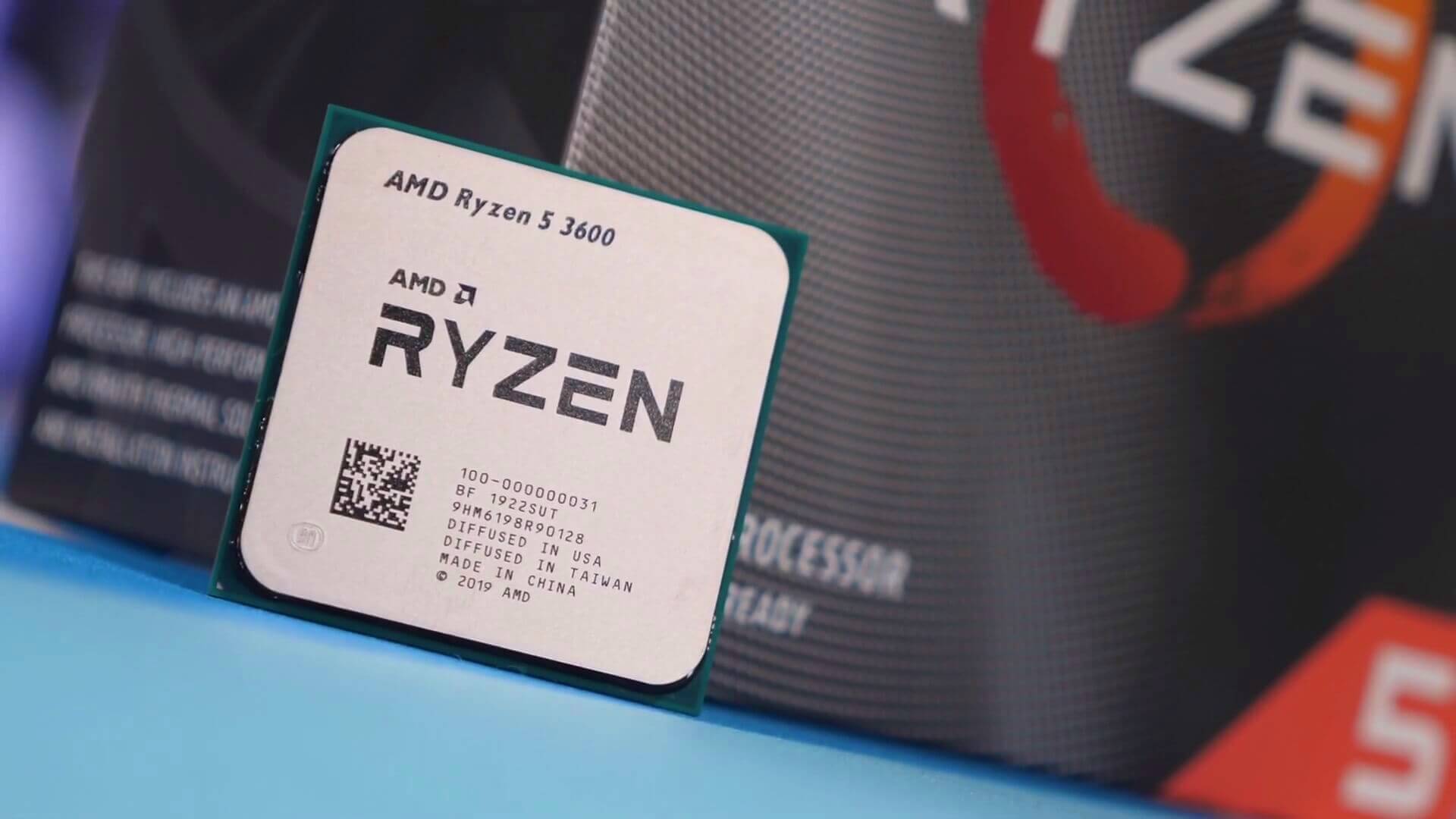
All CPUs have been tested with 16GB of DDR4-3200 CL14 retentivity and a RTX 2080 Ti to reduce any potential GPU bottleneck. All the latest Windows 10 patches, games, drivers and BIOS updates available at the time of testing take been installed. Let's get into the results.
Benchmarks
First up we accept the Cinebench R20 multi-core results and here the 3500X doesn't wait groovy. Yes, information technology's still faster than the Core i5-9400F, but information technology'south slower than even the first-gen Ryzen 5 1600X. It is 6% slower than the R5 2600 and a whopping 27% slower than the R5 3600.
Naturally, for those running wanting to run core-heavy applications, the 3500X might non be the best fit.
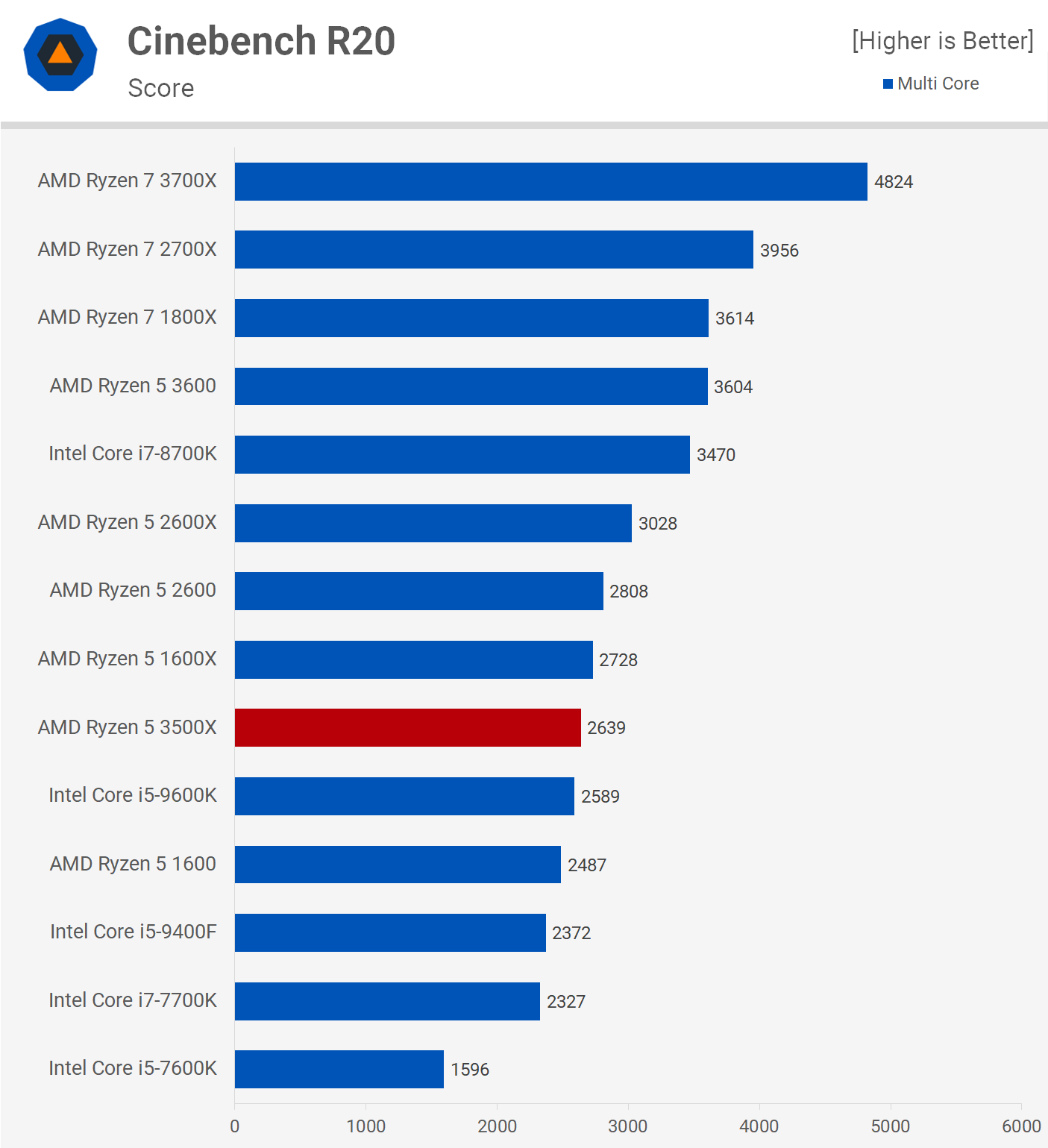
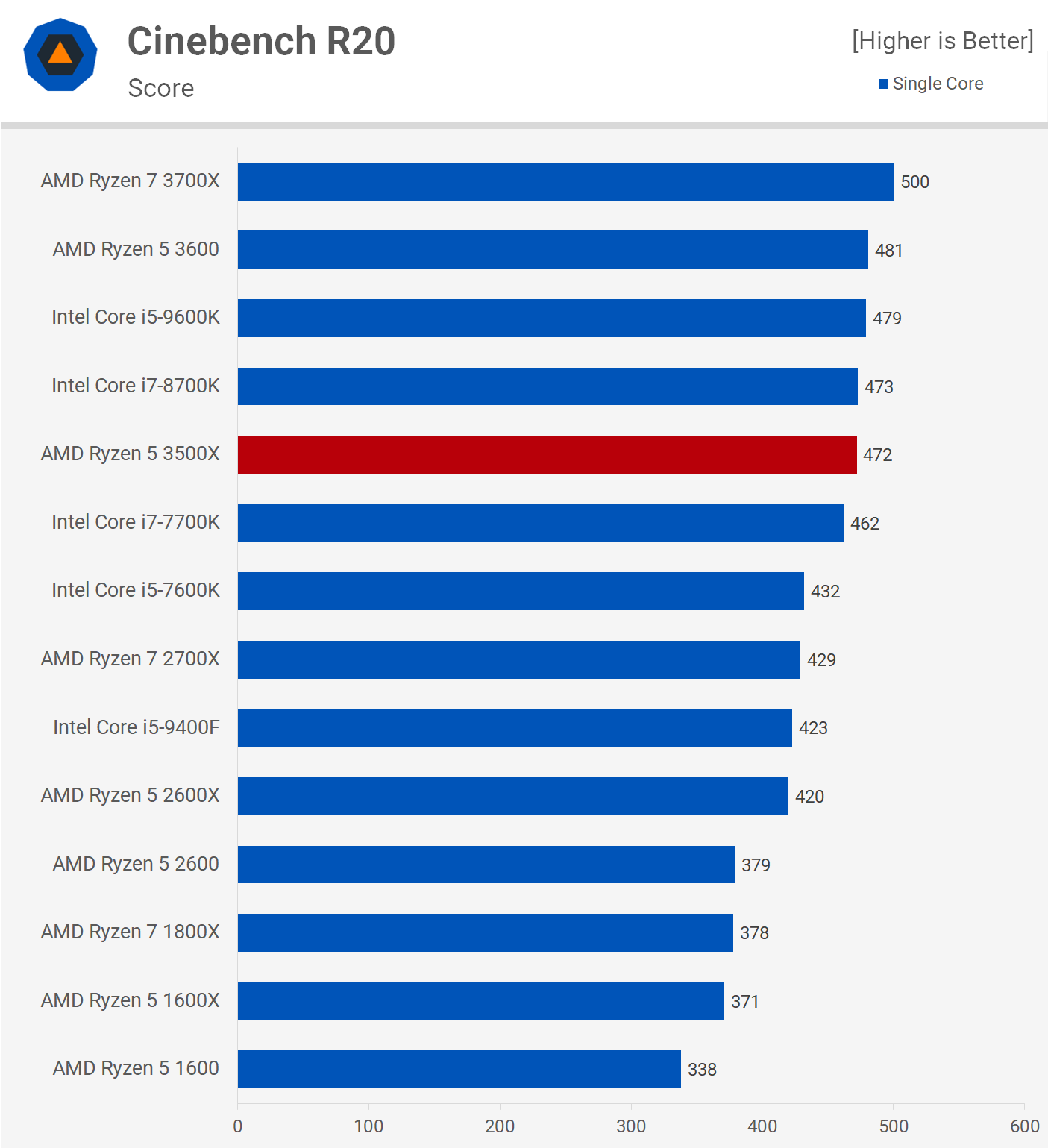
The reward the Ryzen v 3500X has over the similarly priced kickoff and 2d-gen Ryzen parts (1600 and 2600 are 6-cadre/12-thread processors) is the improved single core functioning offered past those Zen 2 cores.
Thus in unmarried-core Cinebench it's basically on par with the Cadre i7-8700K, making it 25% faster than the R5 2600 and even nine% faster than the Core i5-9400F.
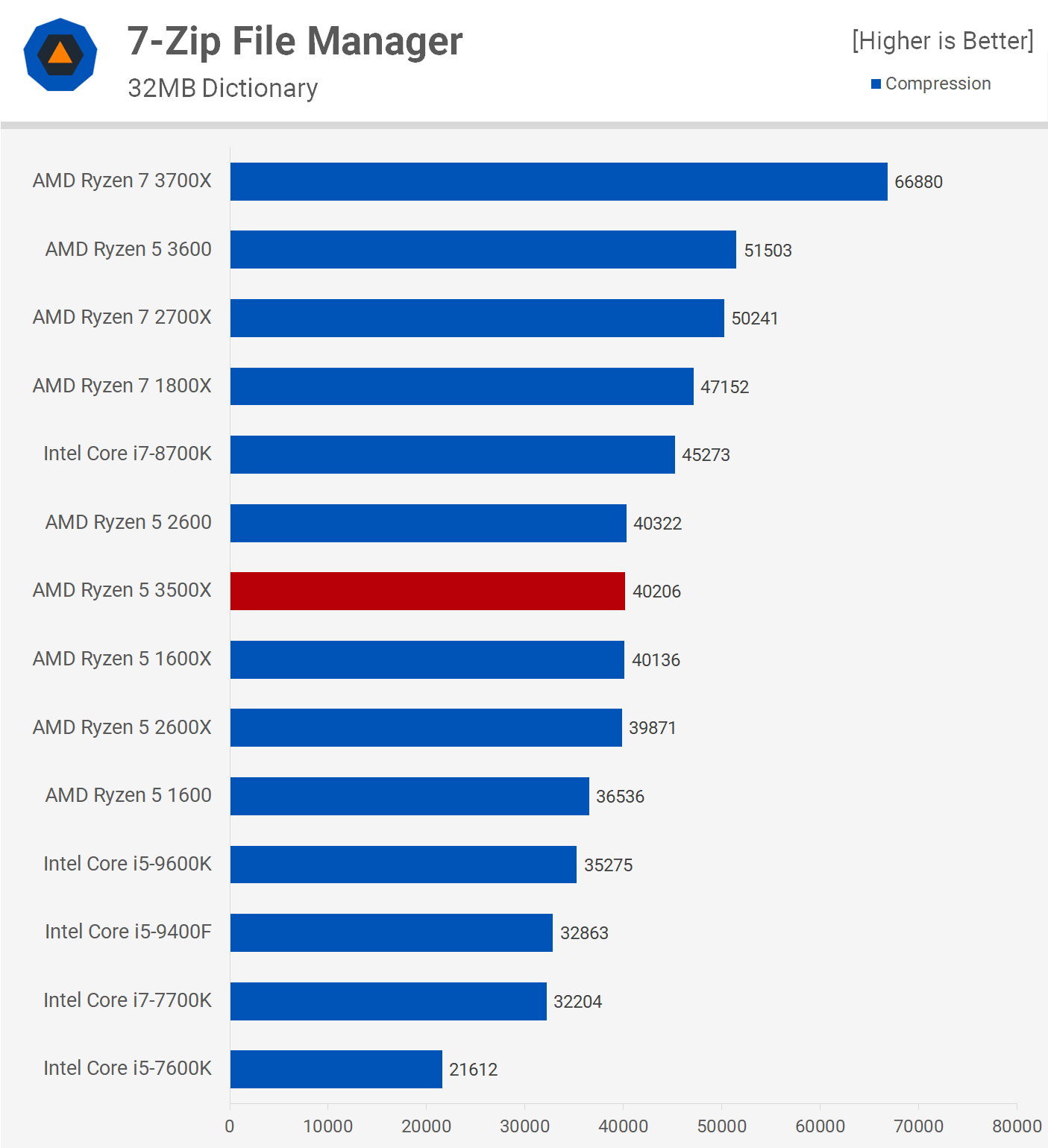
AMD's SMT implementation for first and 2nd-gen Ryzen wasn't specially useful for compression and every bit a event the 3500X is able to friction match the 1600 and 2600 series processors. That said, information technology is 22% slower than the R5 3600, and then a reasonably large drib in performance there.
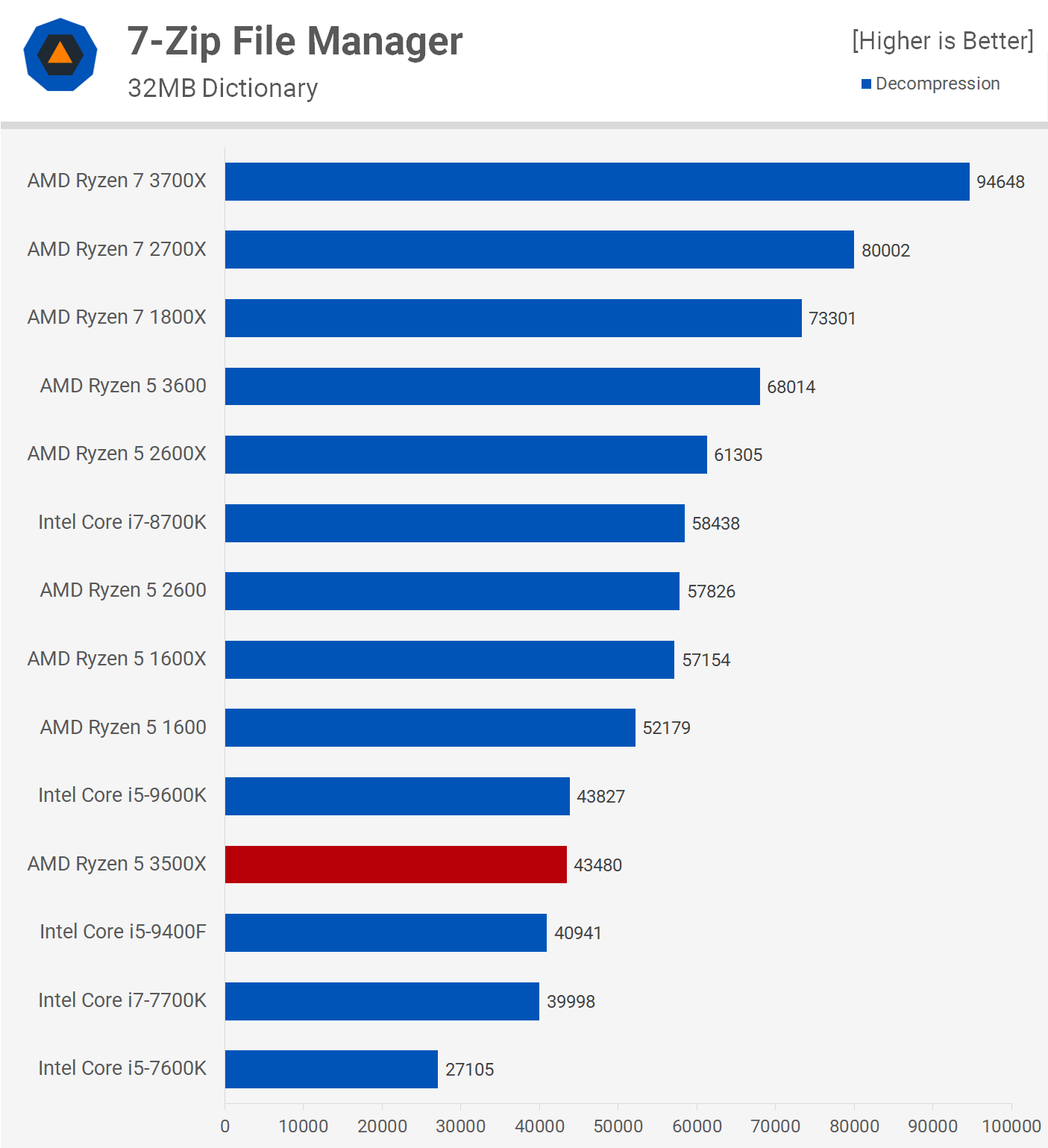
AMD'south SMT has ever worked very well for decompression work, so the 3500X gets blown away as it can merely compete with the Intel Core i5 processors in this examination. This time it was 36% slower than the 3600 and 25% slower than the 2600.
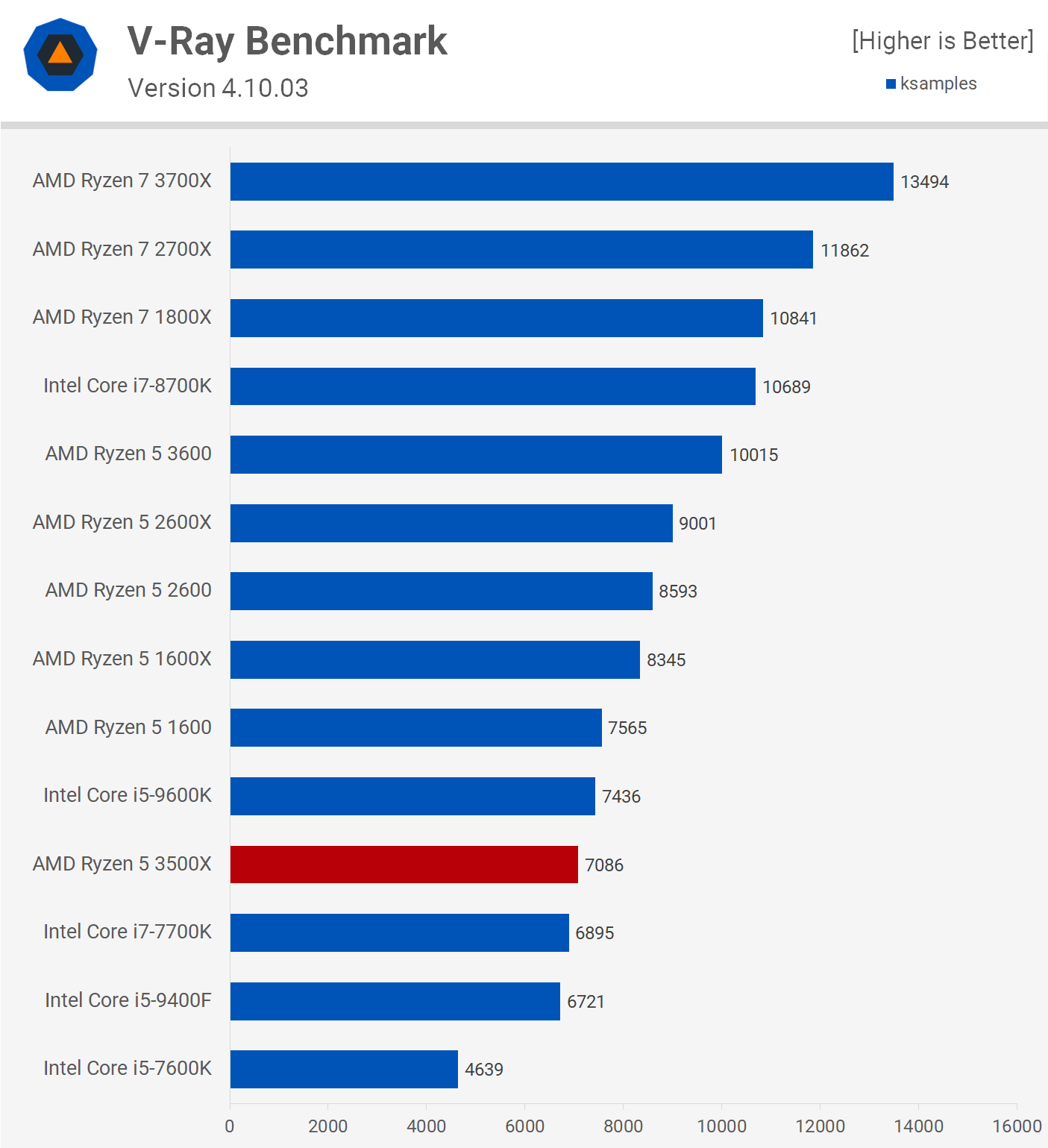
As we saw when testing with Cinebench, for those looking for a budget productivity processor, the 3500X isn't information technology. In Five-ray benchmark we see that the 3500X was half-dozen% slower than the old Ryzen 5 1600 and almost 20% slower than the R5 2600.

Things look even worse when running the Corona criterion, much worse in fact. Here the 3500X is only able to lucifer the Core i5-9400F, which means it's 27% slower than the R5 1600 and 43% slower than the R5 2600. When compared to the R5 3600 we're talking about a 60% increase in render time, so creators on a budget are much meliorate off with a Ryzen 2600 or similar.

We find a like story when testing with Blender, the 3500X took xiv% longer to complete the workload than a get-go generation Ryzen v 1600, significant it was much slower than the R5 2600 and R5 3600.

The removal of SMT back up ways the 3500X loses quite a flake of its power efficiency. For case, where it was 14% slower than the first-gen R5 1600, total system describe is just 10% lower, That figure includes all system components, only still y'all'd expect the newer 7nm function to fair much improve. Even so again, power consumption is hardly a business organisation here as 141-watt full system load for a cadre-heavy workload is nothing.
Gaming Benchmarks
Fourth dimension for some game benchmarks and nosotros'll beginning things off with Assassin'due south Creed: Odyssey at 1080p using the very high quality settings. As a reminder, we're using a high-stop RTX 2080 Ti for testing.
Here the 3500X is comparable to the Core i5-9400F along with the kickoff and second-gen Ryzen 5 parts. That's to say performance is proficient, merely we get the feeling information technology won't exist long before six-thread processors such every bit the 3500X and 9400F become the way of the Core i5-7600K.
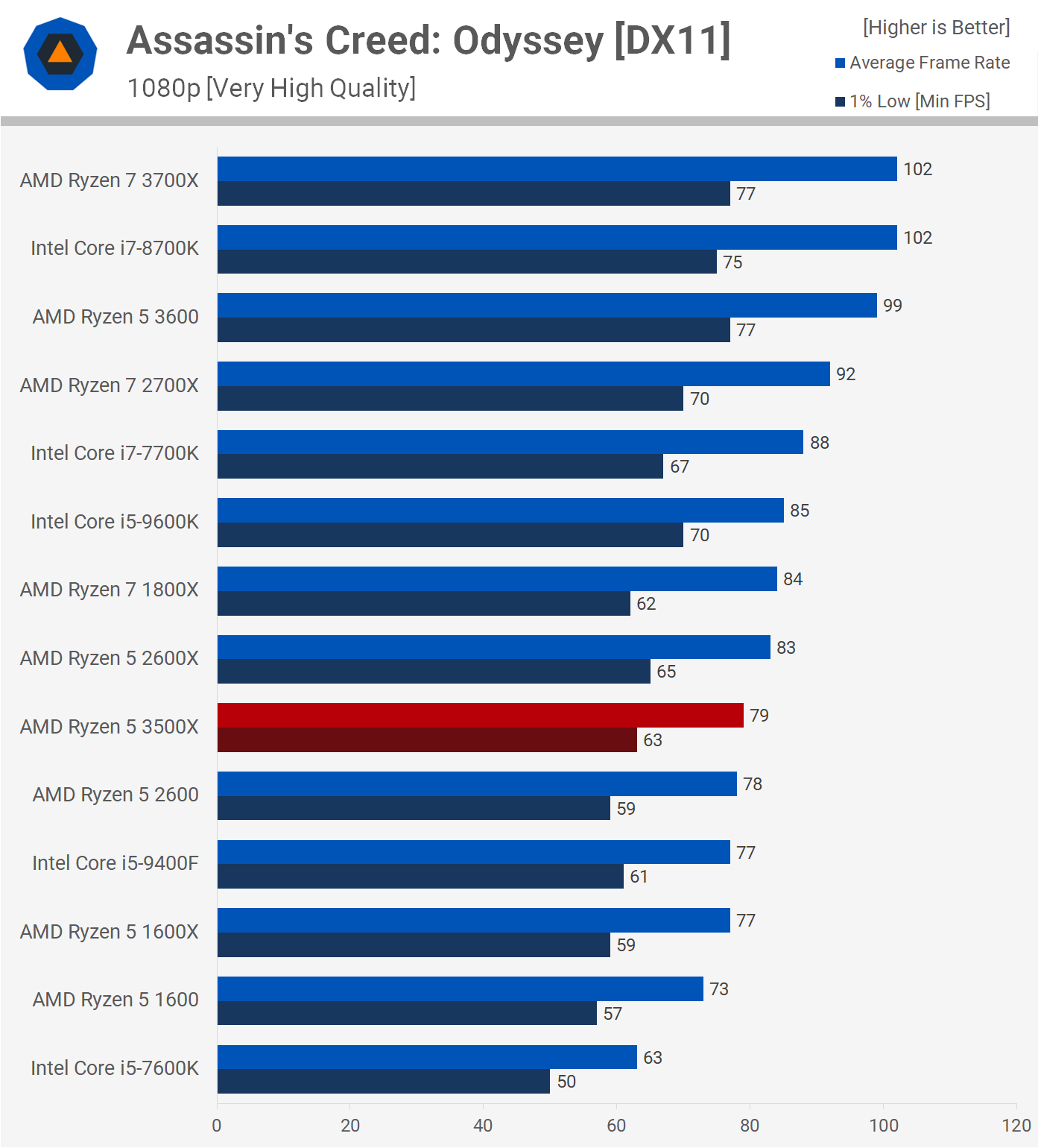

ACO does go a little more GPU bound at 1440p and this helps the 3500X out as it's not able to lucifer the Ryzen 5 2600X, and actually deliver similar performance to the R5 3600. Performance from the mid-range to top end is pretty similar under these more GPU express test conditions.
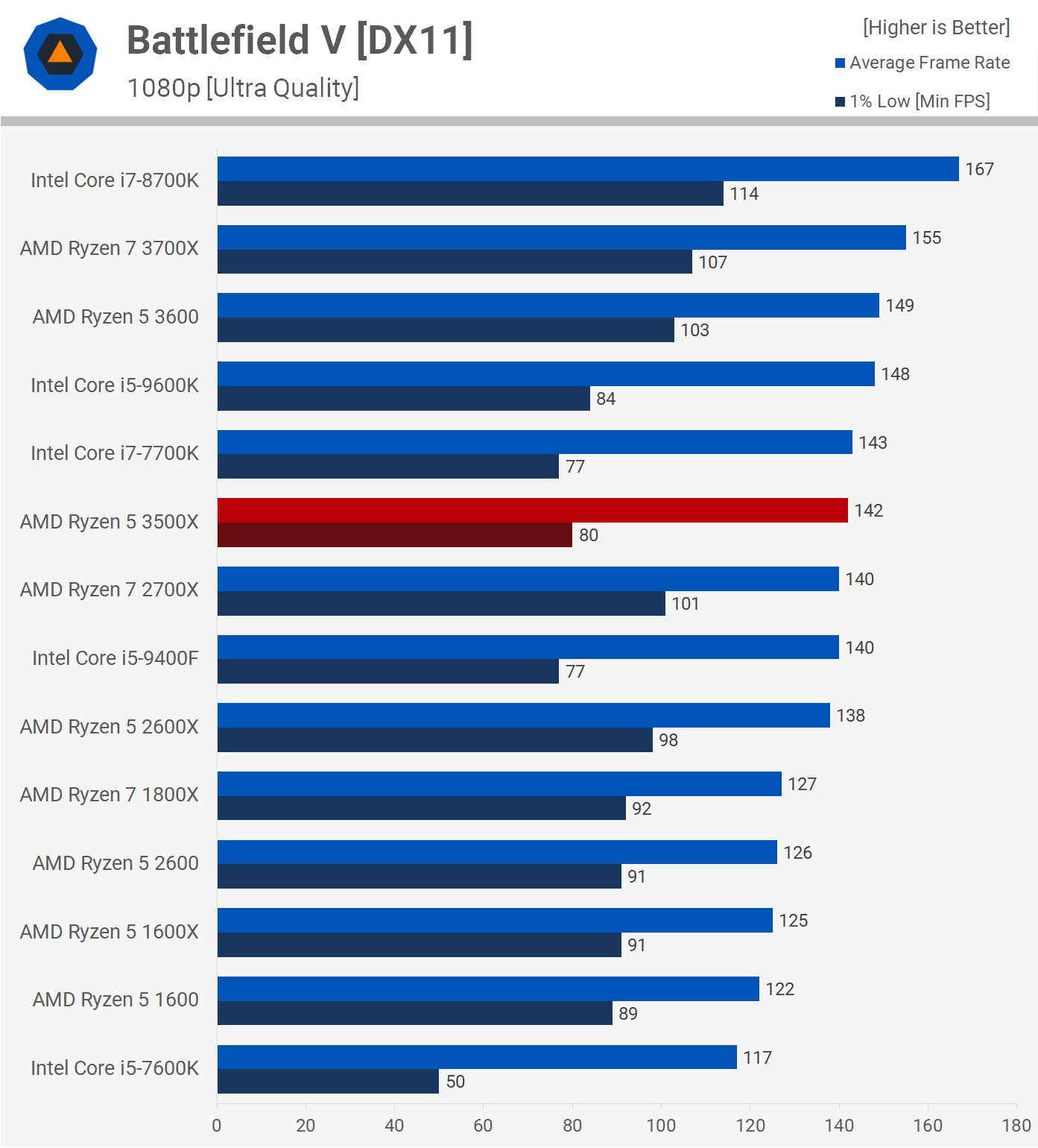
Battleground Five is an example where vi threads or even 8 threads are becoming insufficient. Here the 3500X delivered a similar level of performance to a Core i7-7700K and Core i5-9400F, and although the boilerplate frame rate looks quite practiced it's the 1% low performance that suffers.
Granted the game is still very playable and significantly ameliorate than the quad-cadre 7600K, but you will see noticeably larger frame dips when compared to the 12-threaded and amend CPUs.
The 1% depression performance was improved by eleven% with the R5 1600 and 14% for the R5 2600. However, information technology's the R5 3600 that actually steps things upwardly, boosting one% depression performance by almost 30%.
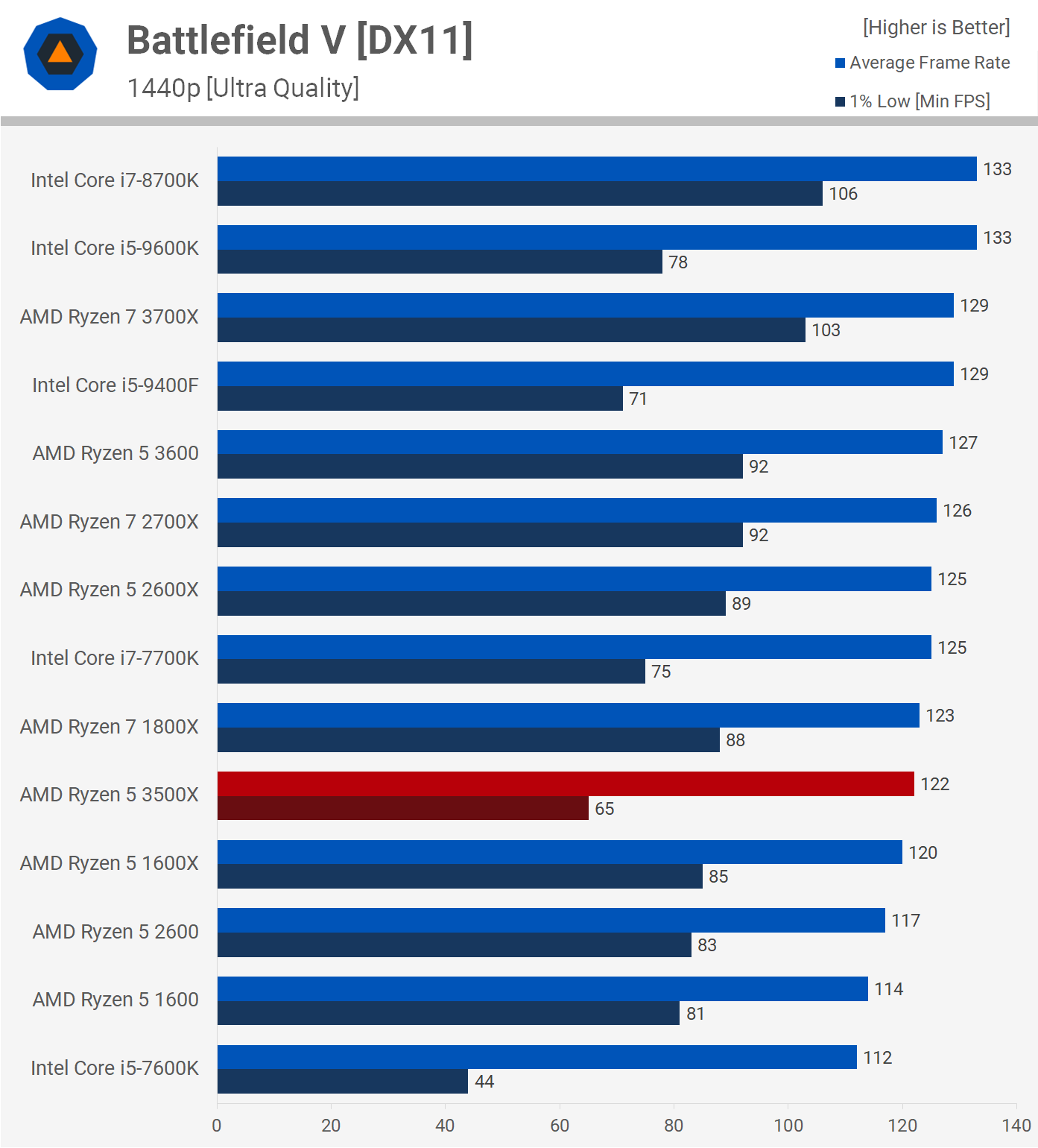
The situation doesn't change at 1440p, rather things just get worse for the vi-core processor. Here the 3500X still suffers a big dip in ane% low functioning and as a result the R5 1600 was 25% faster, so not a adept result for the affordable 3rd-gen Ryzen processor.
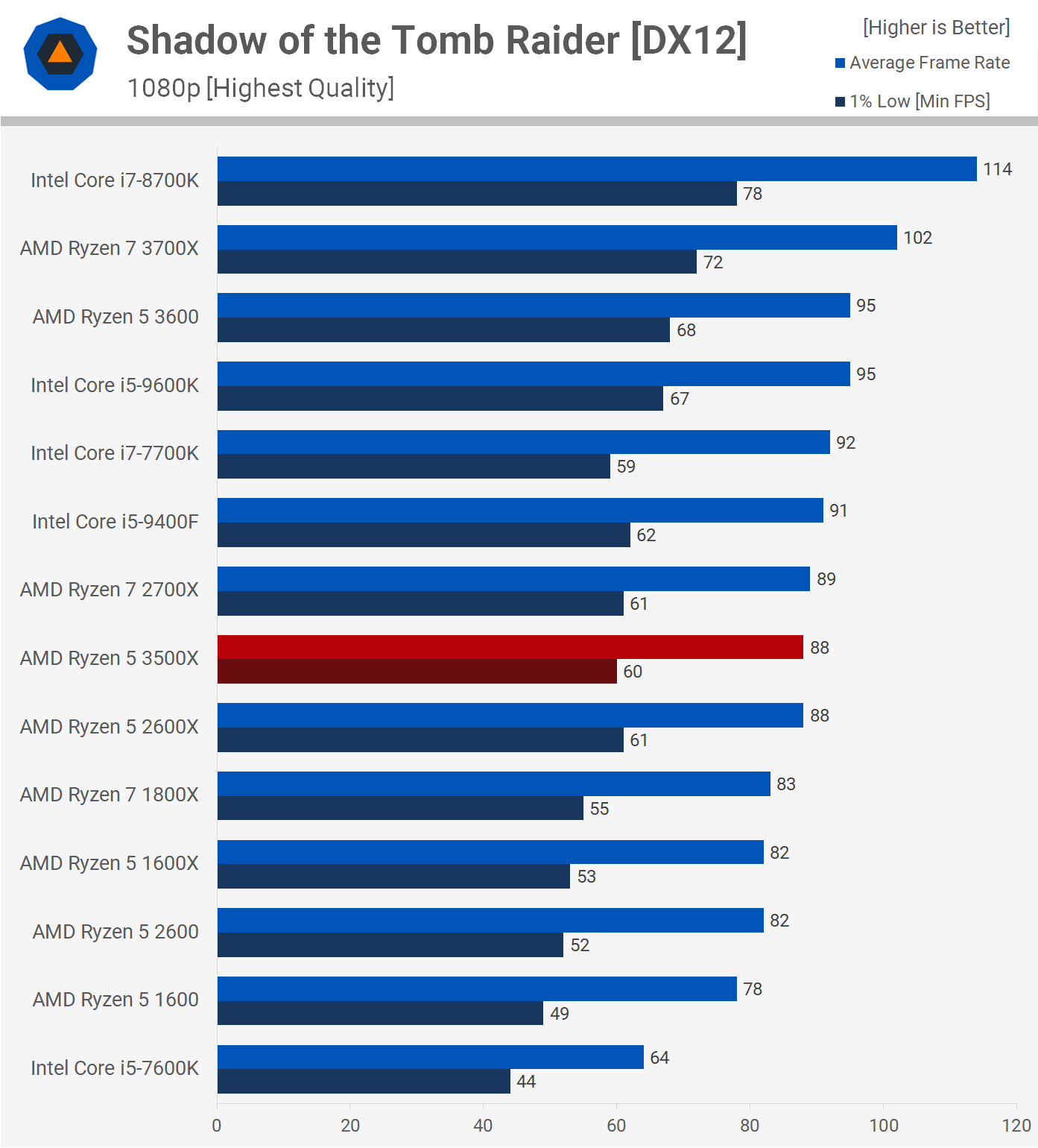
Shadow of the Tomb Raider isn't quite as CPU enervating every bit the first two titles, and every bit a effect the 3500X performs quite well. It's just able to match the 2600X and 9400F, but overall quite a good result.

The margins are similar at 1440p, the 3500X does slip slightly behind the 2600X and 9400F, merely again overall performance was decent.
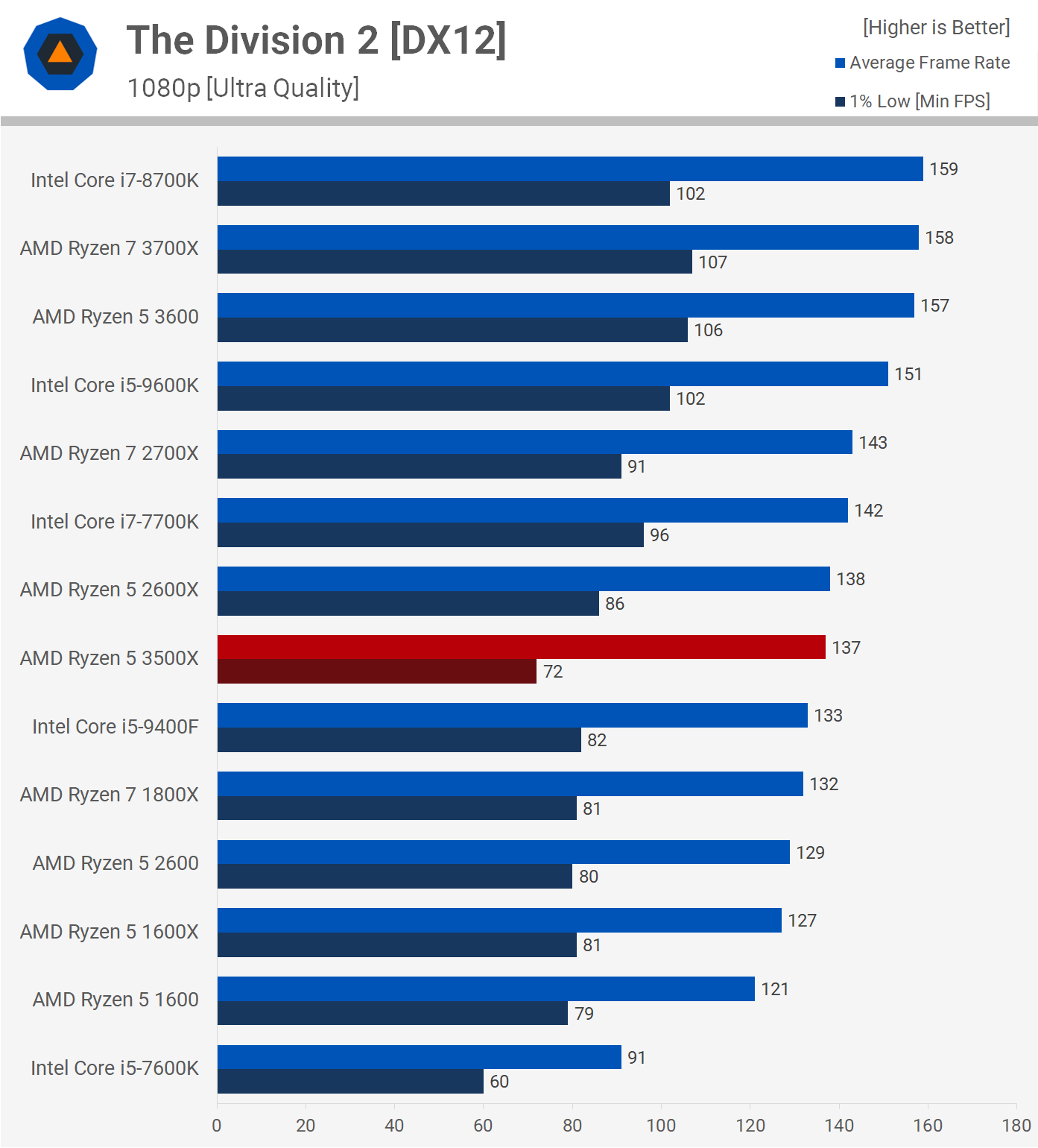
The Ryzen five 3500X besides struggles a flake in The Division 2, delivering poor 1% depression functioning when compared to fifty-fifty the first-gen Ryzen 5 1600. Again we see that the average frame charge per unit functioning is quite expert, but information technology's the 1% low performance that you should focus on here.

Fifty-fifty at 1440p the 3500X falls behind the R5 1600, albeit by just a few frames, but you wouldn't expect a half-dozen-core Zen 2 processors to autumn short of a offset-gen part.

Far Cry New Dawn is the to the lowest degree CPU demanding game we've tested so far, and then unsurprisingly the 3500X doesn't suffer poor 1% depression functioning here, in fact it'due south a piffling amend than the 3600 in that regard. Overall operation was the same and not a peachy deal better than the 2nd-gen Ryzen.

At 1440p we encounter the aforementioned behavior, then for older and less enervating titles the six-threaded 3500X will be perfectly fine, no surprises at that place.

Hitman 2 played well on the 3500X, certainly well enough despite the 1% lows taking a bigger striking than what you'll experience on a modern 8 and 12-thread processor. Performance overall was comparable to the Ryzen v 2600, at least when testing at 1080p.
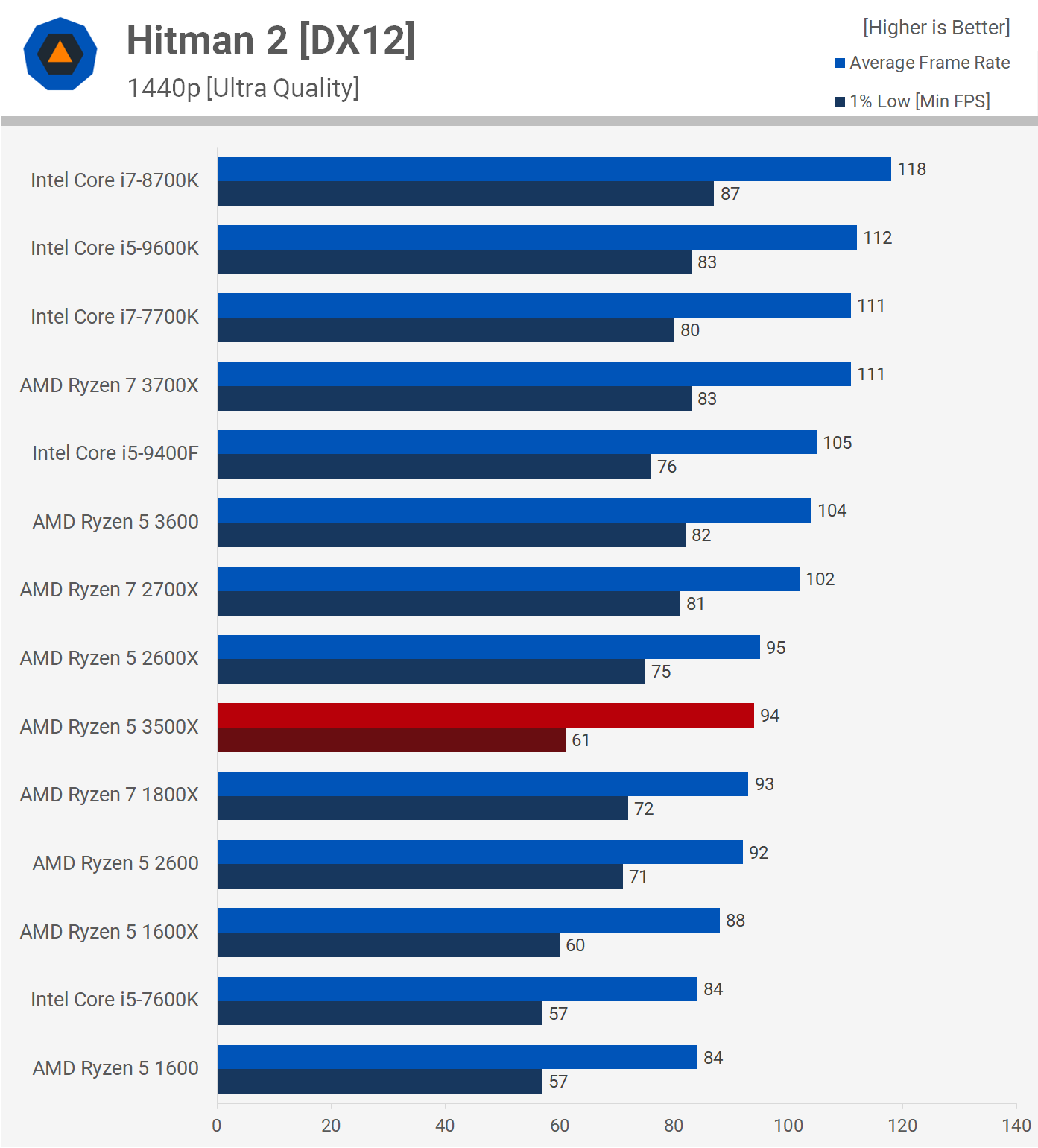
Fifty-fifty at 1440p the weaker than expected 1% low performance persists and although average frame rates are similar to the 2d-gen 2600 and 2600X, the minimum frame rates are much lower.
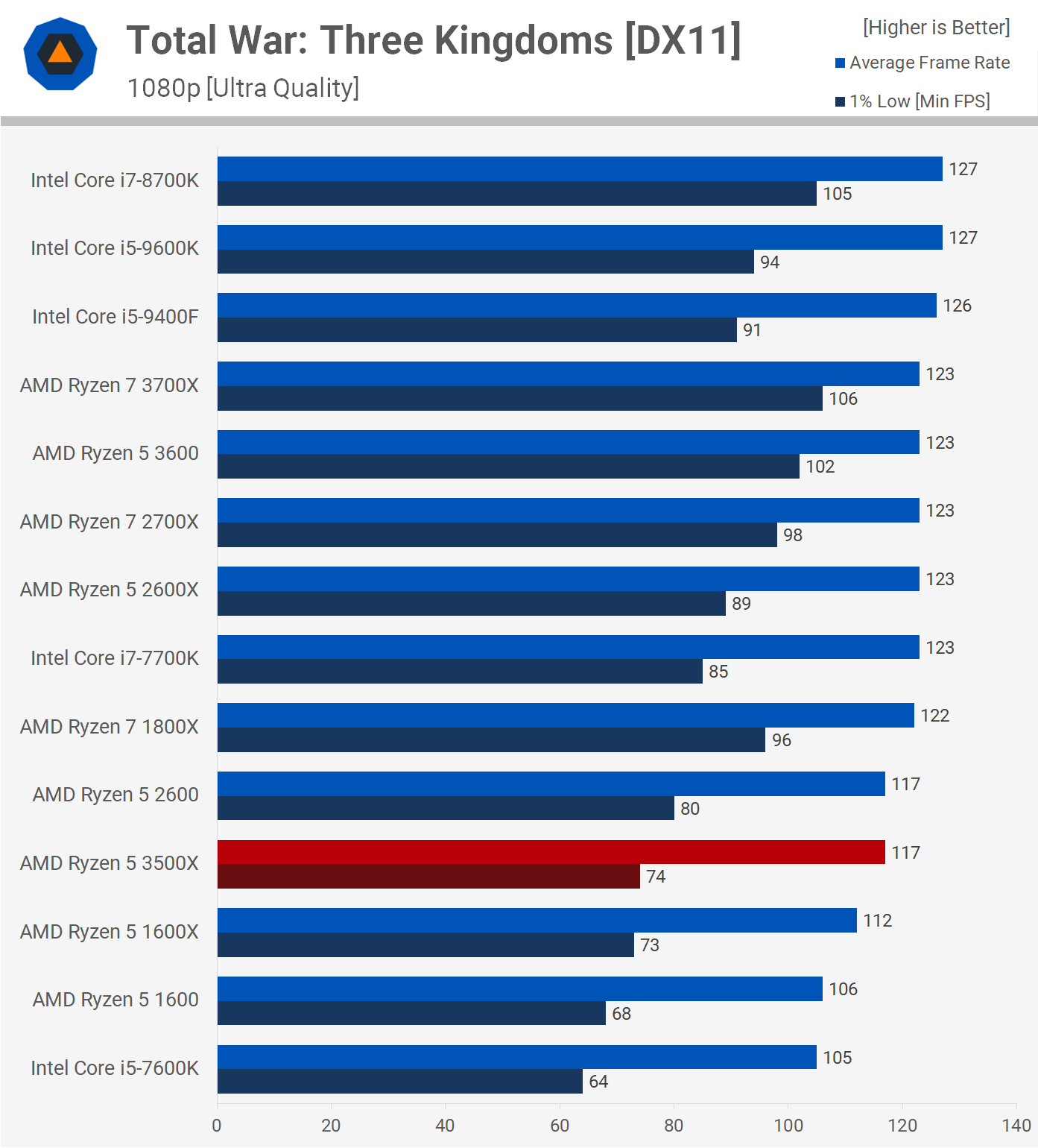
Finally we have Total War: Three Kingdoms and here the 3500X is comparable to the first-gen Ryzen v 1600X, so the 3600 was much better when looking at 1% depression figures. Hither the 3600 was nigh xl% faster which is a massive performance uplift thanks to the use of SMT.

Once nosotros motion to 1440p where the GPU is the most important gene, all margins are nullified and here the 3500X performs much like any other CPU in our chart, it'southward but the R5 1600 that falls a little off the pace hither.
Is It Worth It?
That'southward all the blueish bar graphs we have for you (almost!), at present it's time to decide if the Ryzen 5 3500X is worth ownership, should yous come beyond it. For those ownership today, the best cost we've plant online is $155 and equally nosotros said before, that makes information technology virtually ~twenty% cheaper than the R5 3600 in the US. For swain Aussies, it'due south about thirty% cheaper.
Depending on pricing in your region for commencement, and in item second-gen Ryzen, the 3500X may or may not exist worth it. In us, the Ryzen 5 2600 tin be had for simply $120 and frankly at that price information technology's a much better deal, and that's regardless of what you program on doing with your system.
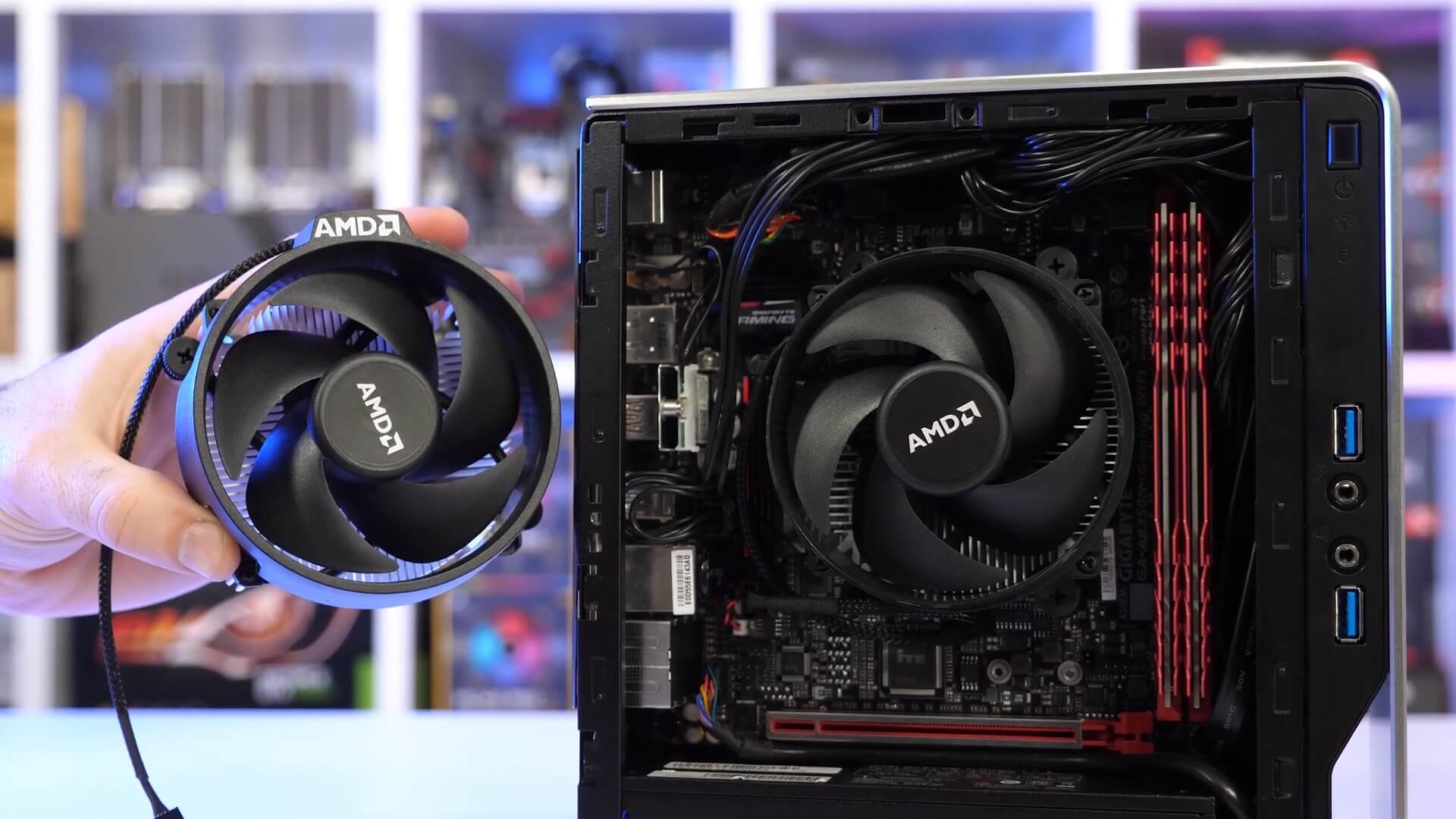
For productivity tasks the R5 2600 is conspicuously the better selection as it was faster than the 3500X in every single core-heavy workload we ran. Couple the better performance with the lower price and you have an obvious winner. Even when it comes to gaming, the superior IPC of the 3500X's Zen 2 cores can't make upwardly for the lack of SMT back up and to better illustrate that, here's a look at some updated toll per frame graphs.
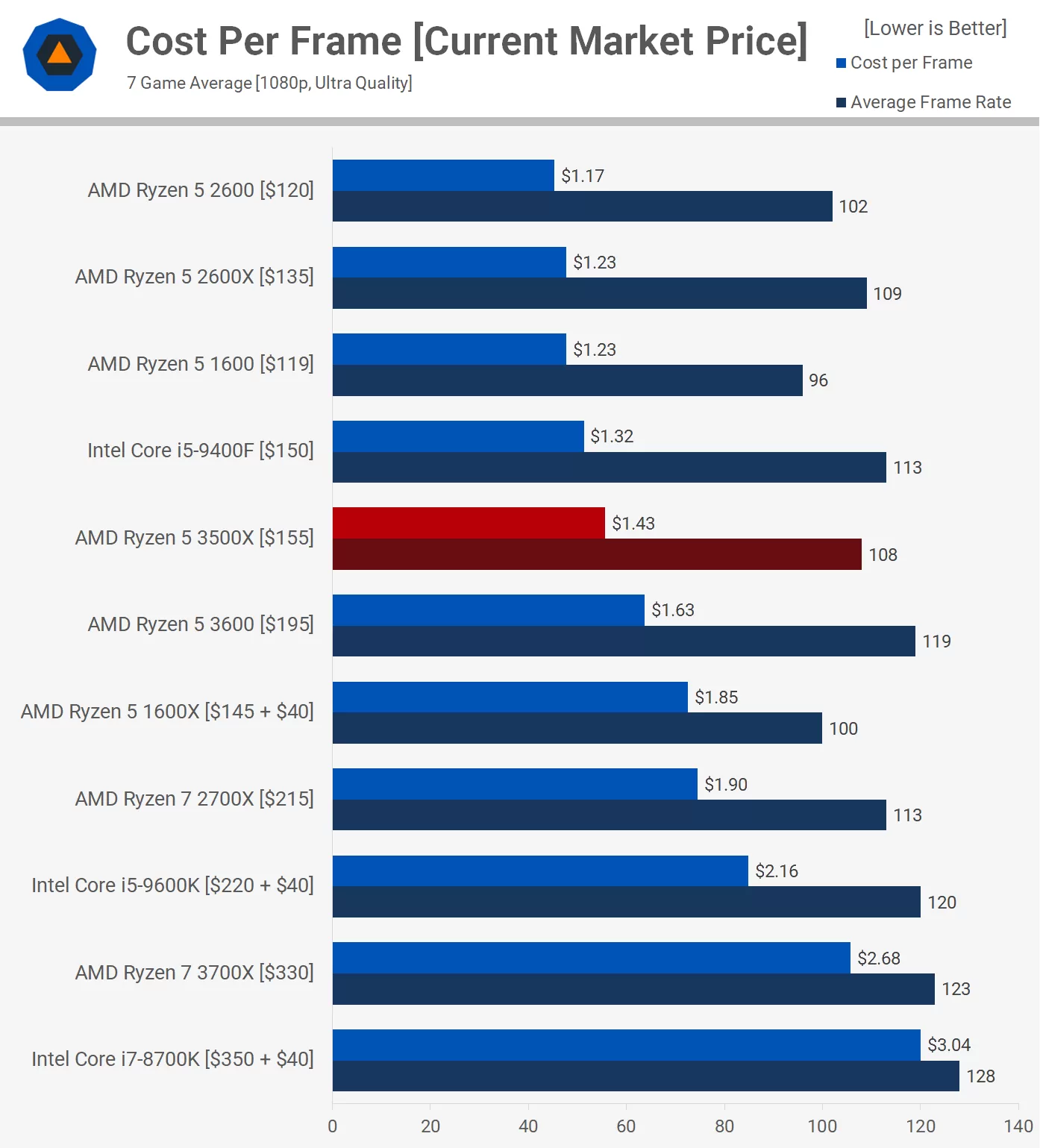
Here we can see when looking at frame charge per unit performance at a 7-game average, the 3500X was only able to match the 2d-gen Ryzen 5 2600. You're looking at spending half-dozen% more per frame which makes it a worse value pick for US and Australian gamers correct now.
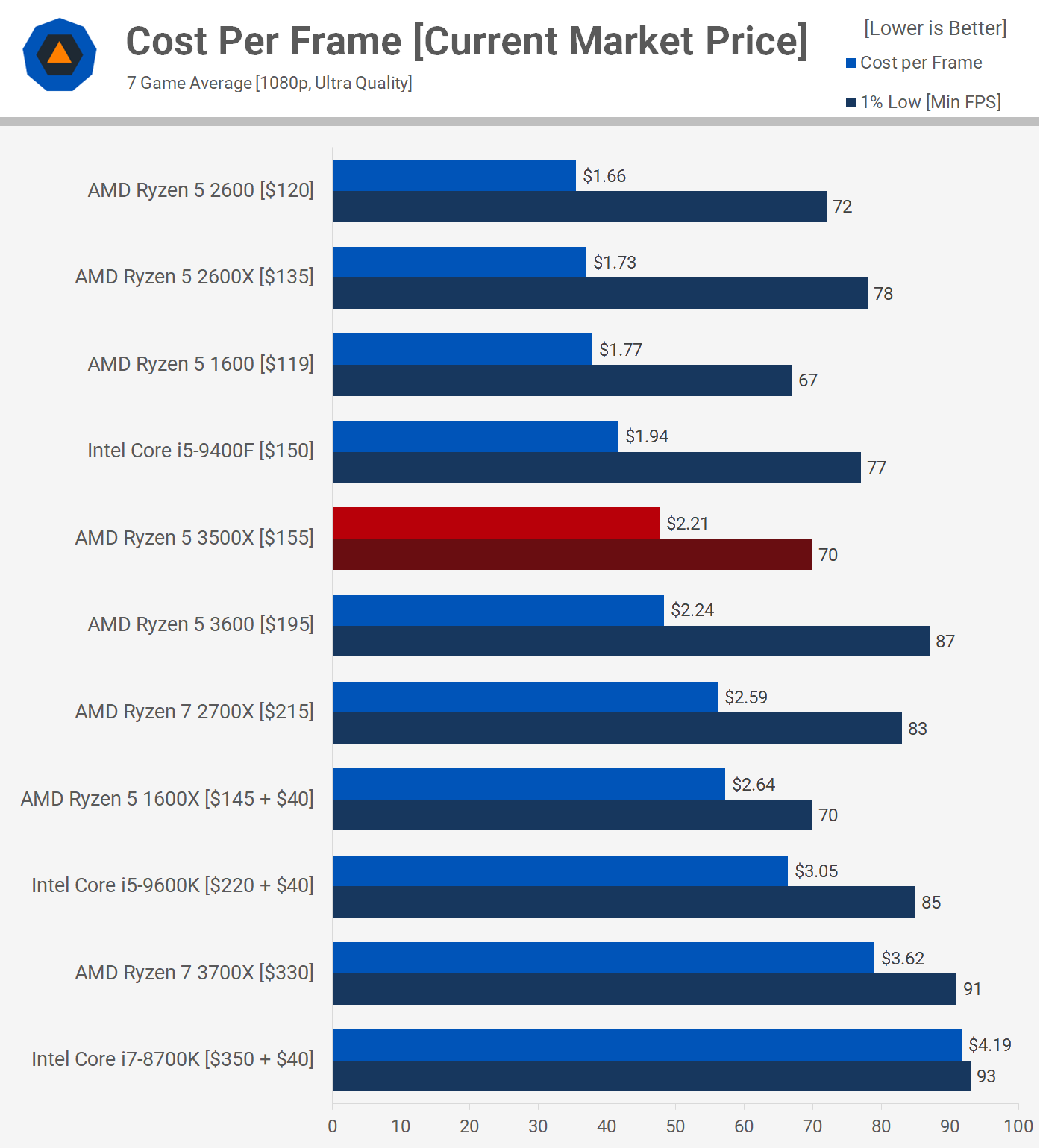
Moreover, if you merely had the choice of a half-dozen-core/6-thread processor for almost $150, the 3500X or the 9400F, we'd get with Intel every fourth dimension for gaming. But since the Ryzen 5 2600 exists, that'south the obvious choice here.
For those concerned well-nigh gaming functioning not just today, but in a year or 2, the 3500X makes even less sense. If we look at 1% low performance across the seven games tested you get a expert idea of how express this CPU will eventually exist.
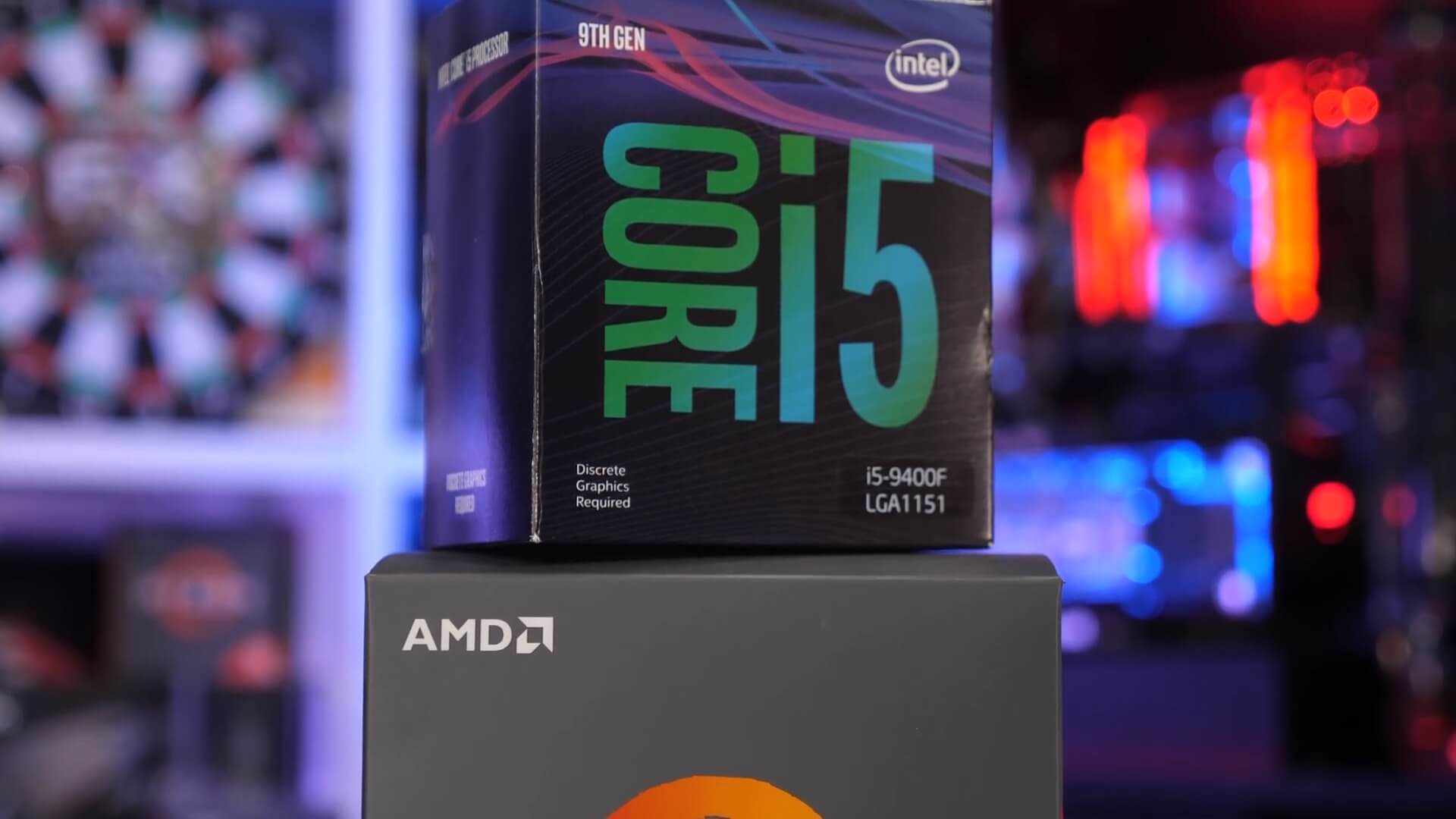
In the absenteeism of outset or second-gen Ryzen parts with more threads, would the 3500X worth buying? If you're mostly gaming we'd recommend the Core i5-9400F instead, while for productivity you could get either way. The actual scenario is that AMD is offloading Ryzen 3600 processors that didn't pass quality assurance to OEMs, and for budget pre-congenital PCs, this might make sense.
For buying off the shelf though, given the warranty issues y'all might run into with the 3500X, the Cadre i5-9400F seems like the better option at $150. Every bit a six-core/six-thread processor, the 9400F probably isn't the wisest investment either. The best budget CPU right now is the Ryzen 5 2600 or Ryzen v 2400G (if you demand integrated graphics) or coughing upwardly the extra $50 for the Ryzen 5 3600, which is an astonishing CPU for the money that will no doubt hold upwardly well for years to come.
Shopping Shortcuts:
- AMD Ryzen 5 3600 on Amazon
- AMD Ryzen vii 3700X on Amazon
- AMD Ryzen 3 3400G on Amazon
- AMD Ryzen 3 2400G on Amazon
- Intel Cadre i5-9600K on Amazon
- Intel Cadre i5-9400F on Amazon
- AMD Radeon RX 5700 on Amazon
- GeForce RTX 2070 Super on Amazon
- GeForce RTX 2060 Super on Amazon
Source: https://www.techspot.com/review/1966-amd-ryzen-5-3500x/
Posted by: phippsolithad.blogspot.com


0 Response to "AMD Ryzen 5 3500X Review"
Post a Comment